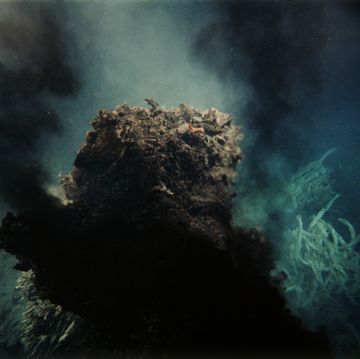- A group of researchers is learning how to talk to whales in order to someday be able to talk to aliens.
- The Whale-SETI team is using humpback whales as proxies for aliens, much like researchers sometimes use “Antarctica as a proxy for Mars.”
- In order to test interspecies communication, the team recently had what they believe s the “first such communicative exchange between humans and humpback whales in the humpback ‘language.’”
At this point in the human story, finding any kind of extraterrestrial life would be the biggest thing anyone has ever discovered. Even single-celled organisms would clarify one of the biggest questions in all of science: are we alone in the cosmos?
But there’s a bigger prize. As much as we would love to find any extraterrestrial life out in the universe, we would really love to find intelligent life. Life that had formed communities and social orders that could show us a whole new perspective on... well... pretty much everything.
Finding that ultimate pot of gold at the end of the cosmic rainbow is the be-all, end-all goal of the SETI Institute. It’s in the name—SETI stands for Search for ExtraTerrestrial Intelligence. The organization grew out of the NASA SETI Program, which operated in the 80s and 90s, and is home to researchers working not only to locate extraterrestrial life, but to be able to understand and communicate with it when and if we find it.
To that end, SETI teams work on a huge variety of projects. And one of those teams just had a conversation with a whale.
In a paper recently published in the journal PeerJ, the Whale-SETI team detailed their attempt at communicating an incredibly smart and incredibly “alien” species right here on Earth: the humpback whale. The goal of the encounter was basically to do a practice run at communicating with non-human organisms and seeing if it was possible to have a “conversation.”
“Humpback whales are extremely intelligent, have complex social systems, make tools—nets out of bubbles to catch fish—and communicate extensively with both songs and social calls,” Fred Sharpe, one of the authors of the study, said in a press release.
And according to the group, it seems to have been possible. The group had previously recorded several whale calls that seemed to have been used primarily for “conversational” style communication, rather than, say, warning of danger or alerting others to food. When the researchers played their “hello” call on an underwater speaker, they got a hello back from a female humpback whale named Twain.
From there, the researchers continued to play whale calls back to Twain, and Twain responded with what are called “whup/throp” calls. Over the course of 20 minutes, the research team broadcast 38 calls and Twain responded with 36, as well as several blow hole blows or surfacings.
After the back and forth was recorded, the researchers analyzed the exchange to see if it could really be called a “conversation,” rather than two creatures just making noises at each other for a while. Defining a conversation isn’t easy, but the researchers worked primarily with a framework centered on the pace of the exchange. They analyzed the time between call and response to see if the noises had the cadence of a conversation—one party vocalizes and the second processes and responds in a reasonable timeframe, taking turns back and forth.
And in the end, they determined that yes, their exchange with Twain should be considered a conversation. Or, at lease, pretty close to it. “We believe this is the first such communicative exchange between humans and humpback whales in the humpback “language,” lead author Brenda McCowan said in a press release.
Eventually, after fine-tuning their process, the team hopes that they will have the opportunity to apply their methods to even more alien creatures—true intelligent extraterrestrial life. But there’s a very important caveat that needs to be applied when trying to translate this experiment to a potential extraterrestrial conversation: the whales talked first. The entire experiment wouldn’t have been possible if researchers were not first able to record and study whale sounds in order to determine their use and play them back to try and communicate further. “Because of current limitations on technology, an important assumption of the search for extraterrestrial intelligence is that extraterrestrials will be interested in making contact and so target human receivers,” Laurance Doyle, one of the authors on the paper, said in a press release.
Basically, we have to assume that the aliens would want to try and communicate with us—broadcasting their “language” out so that we could use it to try and figure out how to “talk” back. But the team seems to believe that the whales’ willingness to talk first is a good sign that aliens may be wont to do the same.
If they ever do, at least we’ll have had a little bit of practice in talking back.
Jackie is a writer and editor from Pennsylvania. She's especially fond of writing about space and physics, and loves sharing the weird wonders of the universe with anyone who wants to listen. She is supervised in her home office by her two cats.













